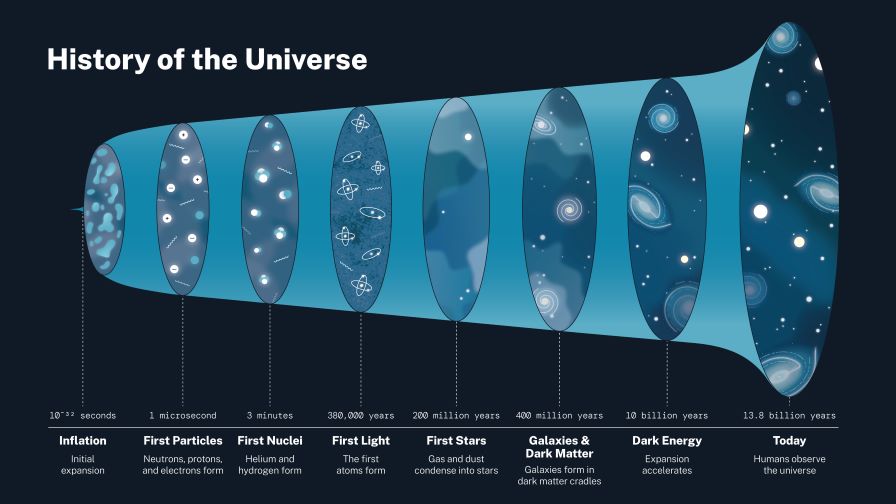Our universe expands at different speed in different directions
The conventional model of cosmology is that most galaxies recede from one another as space itself inflates like the surface of a balloon — which would explain why other galaxies appear redshifted from our own galaxy's point of view. It started with a bang, and has been expanding ever since. For nearly a century, this has been the standard view of the universe and everybody thought it was expanding evenly in all difections. Not anymore.
Our understanding about the universe has suffered a serious blow when astronomers realized that what they used to think was a measurement error in fact is a hard to chew reality. The James Webb Space Telescope has confirmed earlier observations made with the Hubble Space Telescope: our universe is expanding at different rates depending on where we look.
More to read:
[video] Scientists measure the expansion history of our Universe
The findings were published in the Astrophysical Journal Letters and explained in a statement for the general public.
Astronomers have used these telescopes to verify one of the most perplexing problems in physics, known as the Hubble Tension. This issue, which suggests the universe expands at varying speeds in different regions, could fundamentally change our understanding of cosmology. Initial measurements by the Hubble Space Telescope in 2019 revealed the puzzle, and more precise data from the James Webb Space Telescope (JWST) in 2023 solidified the discrepancy.
The collaborative research between the teams managing the two telescopes has eliminated the possibility of measurement error, indicating that there may be a profound misunderstanding of the universe.
"With measurement errors ruled out, we are left with the exciting possibility that we have misunderstood the universe,"
said Adam Riess, the lead study author and a physics and astronomy professor at Johns Hopkins University.
Riess, along with Saul Perlmutter and Brian P. Schmidt, received the 2011 Nobel Prize in Physics for their discovery of dark energy in 1998, a force driving the accelerating expansion of the universe.

Currently, there are two primary methods for determining the Hubble constant, the value that describes the universe's expansion rate. The first involves studying fluctuations in the cosmic microwave background (CMB), a remnant of the universe's first light, using data from the European Space Agency's Planck satellite collected between 2009 and 2013. These measurements suggest a Hubble constant of roughly 67 kilometers per second per megaparsec (km/s/Mpc).
More to read:
Study: our universe might be merging with parallel baby universes
The second method uses pulsating stars called Cepheid variables. These stars' brightness variations allow astronomers to measure their absolute brightness and compare it to their observed brightness. By using Cepheid variables, astronomers can create a "cosmic distance ladder" to measure the universe's expansion rate. However, this method results in a Hubble constant of about 74 km/s/Mpc, a value significantly higher than the one derived from CMB measurements.
This discrepancy led to what some scientists describe as a crisis in cosmology. David Gross, a Nobel Prize-winning astronomer, referred to it as such during a 2019 conference at the Kavli Institute for Theoretical Physics (KITP) in California. Initially, some thought the disparity might be due to measurement errors caused by the blending of Cepheids with other stars in Hubble's aperture.
However, in 2023, the JWST's more precise measurements confirmed the accuracy of the initial Hubble data for the first few "rungs" of the cosmic distance ladder.
More to read:
Scientist says the Universe could be twice the estimated age
To further resolve the issue, Riess and his colleagues observed 1,000 more Cepheid stars in five galaxies up to 130 million light-years away. Comparing this new data with Hubble's measurements confirmed the Hubble constant's value, ruling out measurement error as the cause of the Hubble Tension with high confidence.
"Combining Webb and Hubble gives us the best of both worlds. We find that the Hubble measurements remain reliable as we climb farther along the cosmic distance ladder," Riess said.
With this said, the tension in our understanding of cosmology remains unresolved and continues to challenge scientists’ comprehension of cosmos.
Not everyone agrees with the expansionist theory. Christof Wetterich, a theoretical physicist at the University of Heidelberg in Germany, has devised a different cosmology in which the universe is not expanding but the mass of everything has been increasing. Such an interpretation could help physicists to understand problematic issues such as the so-called singularity present at the Big Bang, the scientist claims.
***
NewsCafe relies in its reporting on research papers that need to be cracked down to average understanding. Some even need to be paid for. Help us pay for science reports to get more interesting stories. Use PayPal: office[at]rudeana.com or paypal.me/newscafeeu.




![[video] Guess who’s hiding more than 8 kilometers below the ocean’s surface?](/news_img/2025/11/13/news0_mediu.jpg)
![[video] Putin rules from shadows: Investigation finds Russian leader rarely works in Moscow](/news_img/2025/11/11/news1_mediu.jpg)

